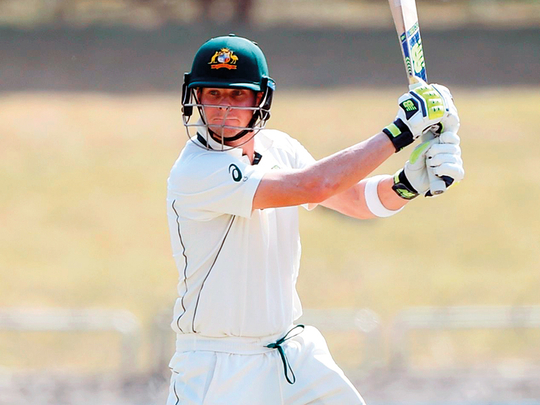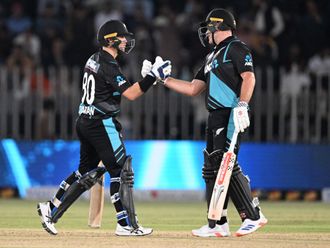
Dharamsala: In the end, Australian cricket’s trip to the Himalayas finished with the luxury of disappointment.
A more complex emotional mountainscape than the victorious Indians: some flicker of chastisement perhaps for the hosts after battling in a series they expected to boss, but mostly satisfaction at finding a way back whenever pushed.
For the visitors though — how to regard letting a golden thing slip when you’ve only fleetingly become aware there was a chance to possess it? The backstory to this campaign has been pre-chewed enough times: the team that South Africa broke in Hobart, the pieces reassembled with a precision that would have left Humpty Dumpty a gentle Easter green with envy.
So here was a new team with a subcontinent assignment, after the whitewash trail of Sri Lanka last year, the UAE in 2014, and the carnival sideshow disaster of the 2013 India tour. To have told this team they would be at level pegging to win the series halfway through the fourth and final Test would have been a revelation, and as far-fetched as the scripture that bears that name.
The existence of disappointment tells you how deeply Australia were in this series.
Minute after minute, hour after hour, the visitors ground away against players who’d been spending most of their lives living in a spinner’s paradise.
The first-up Pune win was no more important than the long-haul Ranchi draw. But three favourable results were needed out of four, and twice the third was there but for two bad hours to wash it away.
Twice Australia returned from lunch for a session that began with a fresh new second innings and ended in a soiled tea-time mess: 101-6 in Bengaluru chasing 188 and 92-5 in Dharamsala trying to set a lead.
In hindsight Pune was always likely to prove anomalous, as Virat Kohli insisted.
Huge margins often don’t reflect the overall quality of the teams, but rather match situations where one has crashed out of the contest early.
But halfway through Bengaluru the Australians were carrying the same momentum, first with Nathan Lyon’s extraordinary 8-50, then more solid batting for an 87-run lead on another difficult track.
It was down to India’s bloody-mindedness that they found a way back, at the tail-end of their 13-Test season. Ajinkya Rahane and Cheteshwar Pujara set the example and created the half chance, Ravichandran Ashwin took it.
India’s lead spinner was so cooked by the fourth Test that the meat was falling off the bones: whenever the ball passed him in the field he preferred to act as a sort of jogging escort to the boundary rope.
His Bengaluru effort, though, gave his team the chance to make a grander scale of save.
A series lost to batting failures leaves hanging the unanswerable question of whether Usman Khawaja might have experienced the same renewal as his team if given the chance.
A liability in Sri Lanka nine months earlier, but Australia’s best of the home summer that followed, including the pressure hundred in Adelaide that started his team’s new era.
At this same Dharamsala ground in the World T20 a year back, Khawaja stroked half a dozen gorgeous boundaries, while a difficult tacky pitch kept his ten teammates to four between them.
Such is his ability when the muse slides into his DMs.
The Mitchell Marsh experiment has had its funding yanked.
The Shaun variant returned results as muddy as ever. The latter was almost a match-winner in Bengaluru, but he either needed more in the first innings or to back it up in the second.
A match-saver in Ranchi, followed by two failures with the series to be won.
Those two half-centuries were notable, but accompanied by five single-figure scores and a 16.
“When they go low, we go high,” was one mantra of last year’s US election; Marsh the Elder does both. Matthew Renshaw won plaudits for 68 and 60 in the first two Tests, offering reassurance at the top of the order that let Australia start the series on the right note. But he couldn’t offer much in any second innings, and by Dharamsala was a spent force worth 9 runs and 39 balls, plus two blunders at slip that perhaps cost the game. No surprise that exhaustion hit a player whose 21st birthday came on the final day of the series, but perhaps it could have been managed or foreseen.
There were other Dharamsala shortcomings: the middle-order failure around Steve Smith’s century in the first innings, Matthew Wade apparently mistaking day three for day five in blocking out the second innings instead of pushing the lead. But overall this was an Australian team unrecognisable from the Sri Lanka tour for the ability to bat time in difficult conditions, to show patience and humility.
None more so than Smith, with his absurd tally of seven hundreds in his last eight Tests against India, and the way he flicks through gears like a Shimano derailleur. So too the development of his bowlers: Lyon finally cracking the subcontinent code, Steve O’Keefe showing how fast he can learn when given a shot, Mitchell Starc again proving his worth in such conditions, Patrick Cummins coming good on all that talk of potential, Josh Hazlewood adding to his armoury. Smith made his comeback to the Test team on the previous India tour of 2013, and showed promise.
Four years later that has flowered into something unrecognisable. Every player in his squad except perhaps Marsh is young enough to return in 2021. If they can take what they’ve learnt, internalise it over those four years, and bring it back as an inherent part of their cricket, that tour may not end in disappointment. Or if it does, it will no longer feel like a luxury.












